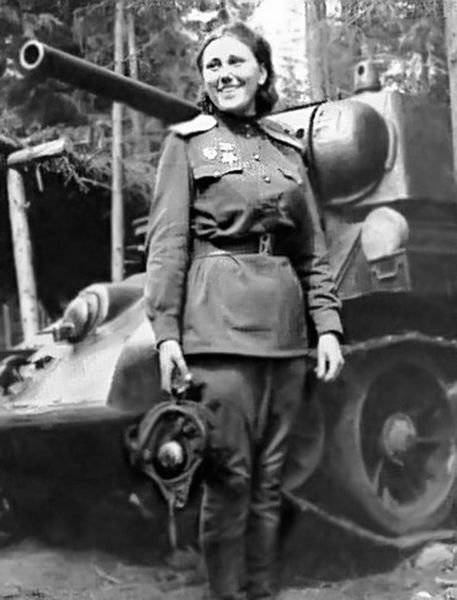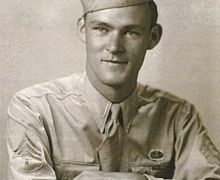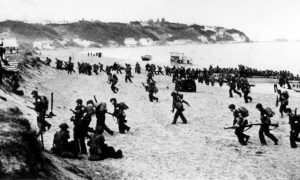Alexandra Grigorievna Samusenko – A Look at the Life of the Soviet WWII Heroine
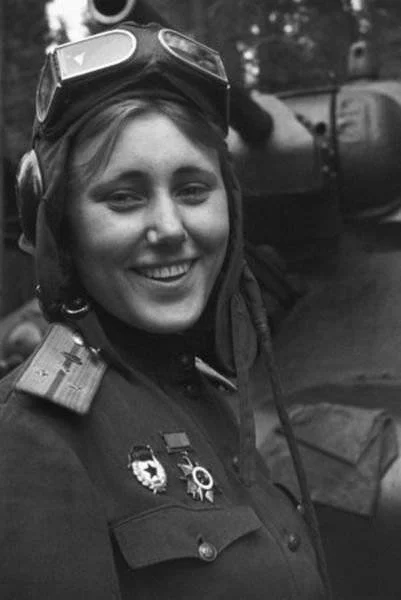 Alexandra Grigorievna Samusenko was a woman who defied gender norms and societal expectations to fight for her country during one of the most challenging times in history. As a Soviet WWII heroine, Samusenko played a significant role in the war effort, contributing to the eventual defeat of the Nazi forces.
Alexandra Grigorievna Samusenko was a woman who defied gender norms and societal expectations to fight for her country during one of the most challenging times in history. As a Soviet WWII heroine, Samusenko played a significant role in the war effort, contributing to the eventual defeat of the Nazi forces.
Who was Alexandra Grigorievna Samusenko?
Alexandra Grigorievna Samusenko – Soviet tanker, communications officer, guard captain. She took part in the Finnish War of 1939-1940, on the fronts of the Great Patriotic War – from June 22, 1941. Most likely, the only female tanker in the 1st Guards Tank Army. Unfortunately, Samusenko did not survive until the end of ww2, she died on March 3, 1945, leaving behind many secrets. Among all Soviet women tankers, she is the most mysterious character who, unfortunately, will no longer be able to tell about herself.
Alexandra Samusenko Early Life
The very date of birth is already shrouded in secrets. It is only known that the girl was born in 1922 (the date and month of birth are unknown). There is controversy regarding her place of birth. For example, according to the words of the chairman of the Belarusian commission to perpetuate the memory of the soldiers and partisans who died during the Great Patriotic War Muza Nikolaevna Ogay, Alexander Samusenko is a native of the Zhlobin district of the Gomel region. She was born in the village of Svyatoe (now Kirovo). According to other sources, she was born in Chita. It is Chita, as the birthplace of Alexandra Samusenko, that appears in the books of memory, as well as in information about irretrievable losses and award lists for her.
According to the order for expulsion from the lists of personnel of the 1st Tank Brigade, her mother is Evdokia Ivanovna Davidenko. The surnames Samusenko and Davidenko suggest that she is Belarusian or Ukrainian. However, in the award lists for the Order of the Red Star and the Order of the Patriotic War II degree, the nationality column indicates “Tatar”. At the same time, the names of Samusenko and Davidenko cannot be attributed to the Tatar ones, as well as the name of her father – Grigory. Another oddity is that the place of residence of the mother of the deceased girl is Moscow (Bolshaya Ordynka).
It is strange that Alexandra Samusenko from 1934 (according to other sources, from 1935) was a pupil in the Red Army. In fact, she became the daughter of the regiment. How it happened that from the age of 12 the girl connected her fate with the army, we also will not know. Perhaps some misfortune befell her parents. Maybe they were repressed (but then it’s hard to believe that the girl would have been brought up in part of the Red Army), or maybe they died.
Perhaps her father served in Chita, who could also be a tanker, and in the future the girl decided to follow in his footsteps. But definitely something tragic happened in 1934 that turned her life upside down. Although the girl could be brought up in the part of her father. One way or another, from the age of 12 the girl was in the army units, and in 1938 at the age of 16 she was accepted into the Red Army. She managed to take part in the Soviet-Finnish war of 1939-1940. It is reported that she met the Great Patriotic War as an ordinary infantryman, being called up by the RVC of the city of Chita. At the front since June 22, 1941.
Samusenko Military History
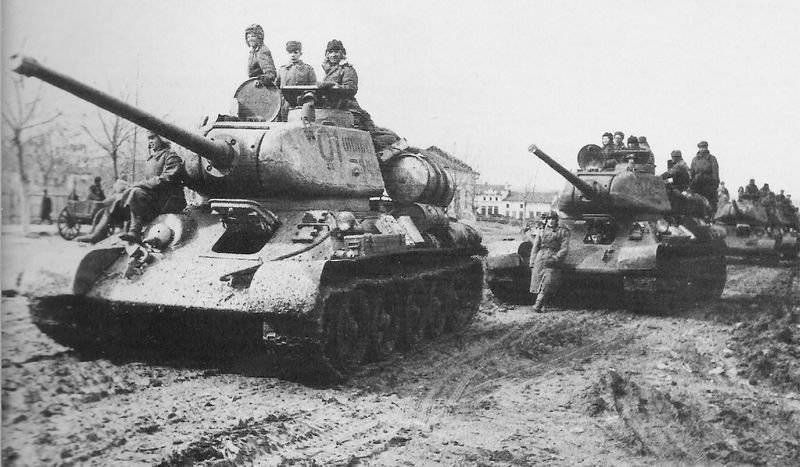 Alexandra Samusenko managed to take part in the heavy battles of the summer-autumn of 1941. She fought as part of the Western Front and the Bryansk Front. In the battles of August and October 1941, the girl was slightly injured. In total, during the Great Patriotic War, she was wounded three times, the last time – seriously, in September 1943. At some point, she wrote a letter to Mikhail Kalinin, Chairman of the Presidium of the USSR Armed Forces, in which she asked to help her enter the tank school. The girl’s request was granted.
Alexandra Samusenko managed to take part in the heavy battles of the summer-autumn of 1941. She fought as part of the Western Front and the Bryansk Front. In the battles of August and October 1941, the girl was slightly injured. In total, during the Great Patriotic War, she was wounded three times, the last time – seriously, in September 1943. At some point, she wrote a letter to Mikhail Kalinin, Chairman of the Presidium of the USSR Armed Forces, in which she asked to help her enter the tank school. The girl’s request was granted.
In the summer of 1943, Alexandra Samusenko took part in the Battle of Kursk as part of the troops of the Voronezh Front. At that time, the girl was already a senior lieutenant of the guard and was a communications officer in the 97th tank brigade. At the end of July 1943 she was presented to the Order of the Red Star. The award sheet stated that in the period from July 19 to July 28, 1943, Alexandra Samusenko was constantly in the battle formations of the brigade, timely providing communication and information on the position of the units and subunits of the brigade taking part in the battle. Under enemy fire and air bombardment, Alexandra Samusenko supplied the units with important instructions necessary for developing further success in battle.
In September 1943, Alexandra was seriously wounded. And already in 1944 she was again in service, took part in the Lvov-Sandomierz offensive operation of the Soviet troops. In 1945, Captain Alexandra Samusenko of the Guards was already transferred as a communications officer to the headquarters of the 1st Guards Tank Brigade. According to some reports, she could hold the post of deputy commander of the 1st tank battalion of the 1st guards tank brigade.
She carried out offensive battles at the beginning of 1945 in the rank of captain, took a direct part in the liberation of Poland from the Nazi invaders. With battles, together with its part, it passed more than 700 kilometers through the territory of Poland and reached the Oder. In February 1945, she met the American paratrooper Joseph Beyrle, who had escaped from German captivity. Joseph Beyrle was able to convince the Soviet commanders not to send him to the rear and stayed with the tankers. Joseph Beyrle became the only soldier who fought in both the American and Soviet armies. His knowledge was in demand, since the brigade was armed with a number of American Sherman tanks.
Samusenko Death
Killed during the East Pomeranian Offensive. On March 3, 1945, Alexandra Samusenko died of wounds received in the village of Tsyultsefirts near the town of Lobez. Today this city is located in the West Pomeranian Voivodeship of Poland. Later, she was reburied in the central square of this city.
According to one version, Alexandra’s death turned out to be ridiculous, as is often the case in war. At night, a column of the 1st Tank Brigade marched along a broken road and came under fire from the Germans. Alexandra Samusenko at that moment was sitting with the fighters on the tank. When the shelling began, she jumped off the armor and, hiding from the fragments over the side of the combat vehicle, began to hit beside her. Suddenly, the tank began to turn around, the driver did not notice people walking in the dark, and Alexandra fell under the tracks. According to another version, she died in battle when she was on a combat mission as a communications officer. An armored car with her near the city of Lobez ran into a retreating detachment of the Nazis. The driver of the car was killed and the car itself caught fire. For some time, Alexandra fired back from the Germans, but then she herself was killed.
April 10, 1945 Alexandra Samusenko was posthumously presented to the Order of the Patriotic War II degree for active participation in offensive battles from January 15, 1945 and the performance of the most important tasks of the command to control the battle. At the same time, during the offensive of the guard, Captain Alexandra Samusenko was always in the battle formations of the advancing units of the 1st Tank Brigade.


